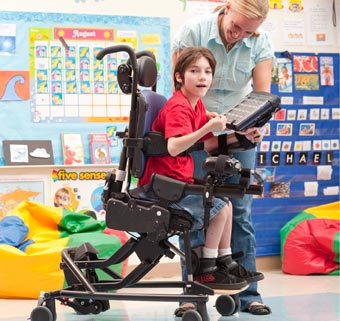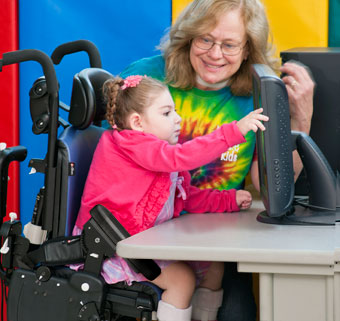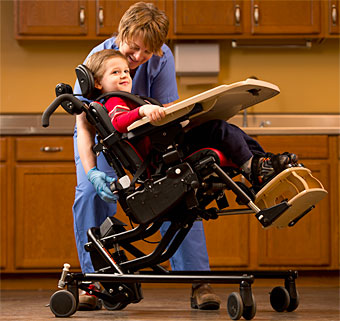
Cerebral Palsy is a result of abnormalities in the parts of the brain that control muscle movements. For children with cerebral palsy, their muscle control, coordination, and posture will be affected to varying degrees by this faulty development or damage to areas of their brain. Cerebral Palsy affects approximately three out of every 1,000 children, and symptoms can range from mild to severe physical disability. Some children with cerebral palsy can have mental retardation, seizures, or speech/hearing deficits as well. Although it is not progressive, cerebral palsy is a permanent condition, and a lack of appropriate positioning and lack of active muscle use may result in worsening secondary impairments. In general, the sooner intervention is started for children with cerebral palsy, the better chance they have of overcoming developmental disabilities or learning new ways to accomplish the tasks that challenge them.
Properly Positioning a Child with Cerebral Palsy
Children with cerebral palsy have difficulty with stationary postures, transitionary movements, and functional mobility. Because postural and motor control problems are central to the challenges facing students with cerebral palsy, they will often spend more time sitting than standing during their day, both at school and at home. It is vital that their adaptive seating provides positioning that is optimal for both health and function. Occupational, physical, and speech-language therapists have a key role in utilizing adaptive seating as an effective intervention.
Positioning with adaptive seating affects health. Spinal and hip deformities are not uncommon in school-aged children with cerebral palsy, yet these are rarely, if ever, present in infancy. When a child with cerebral palsy spends prolonged periods of time in postures and positions that reinforce abnormal movement patterns and deformities, this positioning can contribute toward worsening the student’s musculoskeletal health. Appropriate seated positioning aims to have a beneficial effect on tone, reflex activity, prevention of deformity, maintenance of skin and tissue integrity, and postural stability and alignment, optimizing function. Additionally, appropriate positioning while in adaptive seating can have a positive impact on the pulmonary function of children with cerebral palsy, with implications for capacity for speech and overall lung health.
Positioning with adaptive seating affects function. The postures to be reinforced are those in which the child with cerebral palsy will develop greater postural control, which in turn can contribute toward the movement demands of functional tasks. Thus, adaptive seating for children with cerebral palsy can be the key ingredient for enhancing a student’s function and their ability to perform daily tasks in various environments.
 Research studies have tested the effectiveness of the positioning angles of adaptive seating for improved upper extremity function. This indirectly relates to capacity for attention and participation in the classroom and home environments. Though more research is needed, the evidence across studies suggests that seat inclinations can affect function. However, the angle of seat incline or tilt found to enhance function varies between studies and between children with different types of cerebral palsy. Research has not been conclusive that any one position is necessarily more effective than others for improving sitting posture and active function. Adaptive seating research studies have resulted in a range of findings, indicating that intervention is very individualized. For positioning in adaptive seating, children must be evaluated and treated as individuals. Since the optimal sitting position can vary, careful trials with the student in adaptive seating are needed to determine what position results in increased level of engagement and task performance for that child. Identifying the best seating positioning may require multiple adjustments over a series of visits. In other words, the therapist needs to be patient and persistent.
Research studies have tested the effectiveness of the positioning angles of adaptive seating for improved upper extremity function. This indirectly relates to capacity for attention and participation in the classroom and home environments. Though more research is needed, the evidence across studies suggests that seat inclinations can affect function. However, the angle of seat incline or tilt found to enhance function varies between studies and between children with different types of cerebral palsy. Research has not been conclusive that any one position is necessarily more effective than others for improving sitting posture and active function. Adaptive seating research studies have resulted in a range of findings, indicating that intervention is very individualized. For positioning in adaptive seating, children must be evaluated and treated as individuals. Since the optimal sitting position can vary, careful trials with the student in adaptive seating are needed to determine what position results in increased level of engagement and task performance for that child. Identifying the best seating positioning may require multiple adjustments over a series of visits. In other words, the therapist needs to be patient and persistent.
Upright seat positioning or forward inclined, anterior pelvic positioning shifts the center of gravity forward. This may result in reduced kyphosis, maintenance of lumbar lordosis, and decreased posterior pelvic rotation for a more upright and stable sitting posture. Meanwhile, a posterior or reclined position may reduce pressure on the ischial tuberosities, reduce activity of hyperactive muscles, and also facilitate functional movement development. Research further suggests that a straddled or saddle-seat posture (with hips abducted and externally rotated, and a forward seat slope, facilitating anterior tilt of the pelvis with dynamic weight-bearing through the lower extremities) may improve postural control.

Improving Health and Function with Adaptive Seating
Appropriate use of an adaptive chair that enables a variety of seat and backrest angles as well as forward and backward tilt-in-space, along with appropriate accessory options, can effectively establish a stable pelvis and trunk for active core postural control for a child with cerebral palsy. This postural foundation can, in turn, enable improved upper extremity use for functional task performance and participation. Finding the optimal position to achieve this for an individual student with cerebral palsy in the context of their environment and tasks can be a challenge. The potential for easily varying the seat-to-back angle and tilt-in-space adjustments of the Rifton Hi-Lo Activity Chair, along with appropriate use of the accessories not only can optimally position the child for their physical health benefits, but can also impact numerous daily activities. Capacity for use of communication devices can be improved, feeding or self-feeding can be radically enhanced, and provision of personal care such as teeth-brushing or hair-cutting made easier. Occupational therapists, physical therapists, and speech-language pathologists can be instrumental in providing instruction and guidance for optimal positioning in the Rifton Hi-Lo Activity Chair throughout the child’s day.
The Rifton Hi-Lo Activity Chair can play a vital role in adaptive seating for health and function in the school and home for children with cerebral palsy. With the pelvis positioned for stability and mobility, and with the body properly aligned, this device can produce positive effects for physiological structure and function, as well as activity and participation outcomes for early intervention and school-age children. In the classroom, the Rifton Hi-Lo Activity Chair is considered an assistive technology device or a modification to the curriculum and is appropriately provided under IDEA through the IEP or through supplementary aids and services. For use in the home, providers can make a strong case for medical necessity, allowing for reimbursement through private insurance or Medicaid.